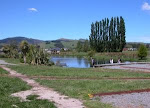 |
| Cut grass being turned ahead of baling. Photo credit: L. Hawke |
Recent grass fires around Canterbury have led to an increase of unease among those who are all too aware of the flammable nature
of grass over summer. It was therefore a great relief to me to get the paddock
topped in early January (topping is when the grass is cut, as if for hay, but
left to lie on the paddock instead of being baled). While the grass is still
very flammable, the shorter length reduces the fuel available to any fires. It
also makes the fire more survivable for any stock, indeed, in the Victorian
bushfires those stock that survived were often on well eaten out paddocks.
The various fruit and nut trees around the paddock are in
full swing, with plums and elderberries ready to be harvested (if the birds
don’t get them first). The four walnut trees have started producing nuts, and I
expect that I will soon hear the chatter of feasting possums. The apple trees
are also producing fruit, though it will be a while before the apples will be
ready to eat. I have experimented this summer with growing pumpkins on the
horse manure pile. I was worried that the only thing I was going
to get from them was leaves, but they have just started flowering, so watch
this space!
The welcome swallows that I mentioned in my last article are
doing well. At least one pair managed to successfully raise a handful of
chicks, so we now have nine resident swallows zipping around the paddock,
snapping up insects as they go. I have resumed feeding one of the horses oats
ahead of winter, and it is difficult to tell who is more enthusiastic about
this development: the horse, or the sparrows! Every evening a crowd of sparrows
now perches patiently on the fence wires, waiting for the horse to either move
off, or tip over her feed bucket. As the days start to shorten this will become
less of a feature, as these opportunistic birds will have retired for the night
by the time the horses are fed.


No comments:
Post a Comment